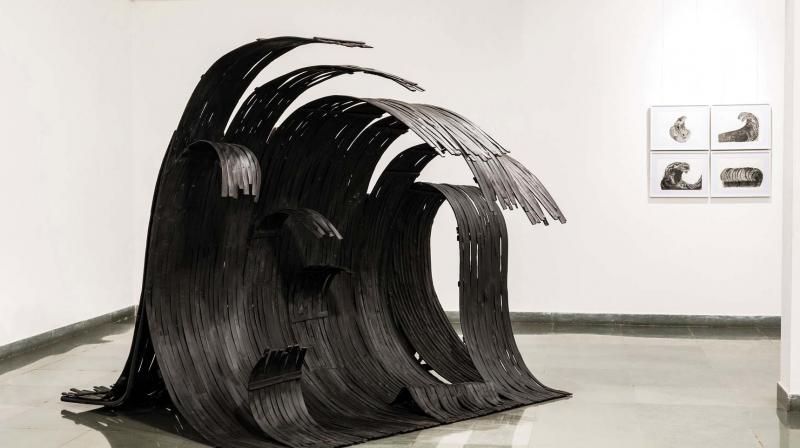From Paper to Bamboo & the face of a woman
A city gallery will be presenting the works of three artists at the upcoming India Art Fair in New Delhi.

The annually held India Art Fair (IAF) in New Delhi brings together galleries, artists, collectives, private foundations and new generation of art buyers, reflecting the art scene of the country.
Unlike most festivals held in the country, this event reflects the contemporary art market. Within such a large congregation of works from all over the world, it takes some out-of-the-box thinking to literally stand out.
This year, will have a strong Bengaluru connect. The works of Ravikumar Kashi and Shanthamani Muddaiah have been chosen by Gallery Sumukha to be presented at the festival and it is interesting to see how these two artists, known to work with unusual mediums, have been so noticeably different.
In the local art world, Kashi’s name is synonymous with his chosen medium of paper. Trained in painting and printmaking at the prestigious M S University, Baroda, he has learned handmade papermaking from Glasgow School of Art in UK and the craft of Hanji, the traditional Korean papermaking from Jang Ji Bang in South Korea. For the IAF he chose a set of thirty small format works, titled White Memories, made with paper made of cotton rag pulp.
KASHI’S WHITE ON WHITE
Etching out forgotten day-to-day objects on Plaster of Paris slabs with sharp woodcut instruments, Kashi pressed fresh pulp onto the slabs and let them dry. Two days later, the inundations deep in the paper were ready to be displayed. By framing them in white, these white on white impressions are physical manifestations of what he calls as “faint memories”. There are memorabilia that a certain generation would identify with - a glass bottle with a spray pump which was a crude device to spray water on the hair of customers in tiny barber shops, a small handheld net contraption to catch small fish, and so on.
By deliberately keeping them small sized, Kashi’s visual strategy of getting viewers to come closer to his works may just be a winner. “In an art fair like this, with so many works, I believe my works are different enough to pique the curiosity of viewers,” he said. With barely a couple of artists working on paper in the way he does, the artworks are also a testimony of his belief in it. “Paper is not only malleable and durable, it is also a way of documenting for me without having to use words.”
GRAPHITE TO BAMBOO
Shanthamani, on the other hand, is known for her graphite based works. However last year, she had displayed a monumental Wave at Sumukha made from an extremely eco-friendly material - bamboo. Wielding a blowtorch, Shanthamani had coaxed bamboo to dip and rise in the form of a massive wave. The black (burnt effect) imposing sculpture highlighted the artist’s principle of working with environmentally friendly materials. “Bamboo has the hardest fibre in wood and we can replace it for all our wood requirements in life,” she said. “It will be interesting to see the new ideas and possibilities that could be adopted across creative fields with architects, designers, furniture makers use this eco-friendly, sustainable solution.”
Apart from the Wave which will be placed in the Sculpture Project section of the IAF, two other works will be displayed at the gallery space there. One is Shanthamani’s Landscape/Fire Script which uses wood charcoal on plywood to create a stark, dystopian landscape. This wall-mounted work will be accompanied by a floor standing bamboo sculpture, Argya/Drop inspired by elements of Halebid and Belur architecture and imagined as a drop of ink splattered on earth. Having been preoccupied with carbon - cinder - for years now, Shanthamani feels that the new medium of bamboo and her approach will make the artworks an interesting study.
THE HEAD OF A WOMAN
The gallery will also be taking the works of Vizag-based senior artist G Ravinder Reddy whose works are easily recognised in the art world. Gigantic, vibrantly coloured heads of women noticed by the artist in his surroundings usually made in bronze, fibreglass or terracotta are his USP. The works are radically different in terms of concept from the other two artists. While monochrome is their forte, Reddy’s works stand out for their sheer opulence and colour.
Overall, it will be an interesting medley of works hobnobbing with each other. In the process, they may just get the desired attention.
